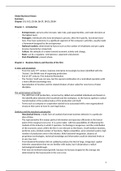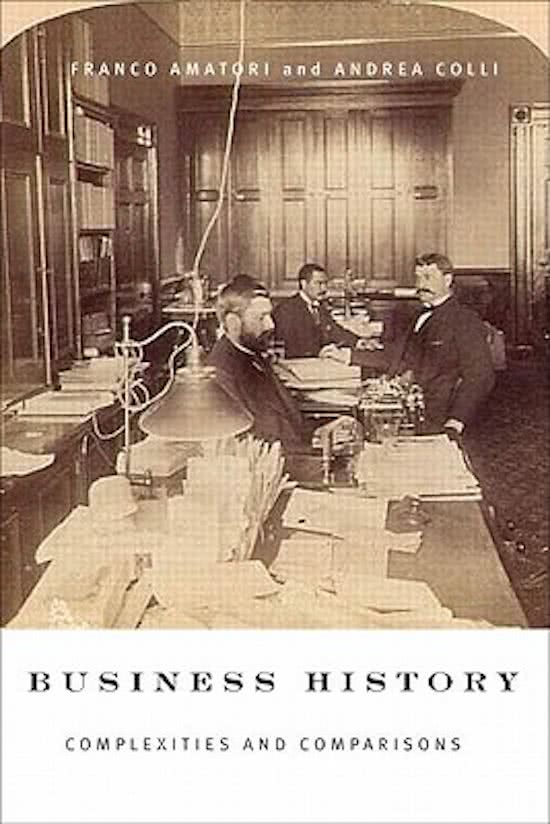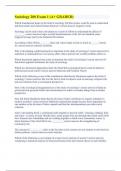Global Business History
Summary
Chapter 1-3, 5-11, 13-14, 16-17, 19-21, 23-24
Chapter 1 – Introduction
- Entrepreneurs: persons who innovate, take risks, grab opportunities, and make decisions at
the highest level.
- Managers: individuals who have developed a precise, often firm-specific, functional know-
how. They have autonomy in a significant segment of the company’s activities, usually inside
a framework designed by the entrepreneur.
- National markets: determined by factors such as the number of inhabitants and per capita
income. Dynamicity is important.
- Culture: the attitude of a nation toward economic activity and change.
- State: can be a regulator, entrepreneur, opponent and planner.
- Post-Chandlerism: present phase.
Chapter 2 – Business history and theories of the firm
A ‘new’ unit of analysis
- From the early 19th century, business enterprise increasingly has been identified with the
‘factory’, the British way of organizing production.
- End of 18th century: First Industrial Revolution.
- The ‘factory’ itself was not new, but the special combination of a centralized operation with
a more efficient technology was.
- Specialization of function and the related division of labor called for new forms of labor
discipline.
The varied nature of the firm
- The shift from craft production, carried out by skilled and unskilled individuals and based on
the identification between the household and the workplace, to the factory sparked a radical
transformation of the juridical status of the production unit itself.
- Terms such as company or corporation started to be associated with a new organizational
structure that came to have its own legal status.
Statistics and the neoclassic perspective
- Neoclassical theory: a static form of analysis that treats business behavior in a particular
slice of time.
- The representative firm enjoys perfect information and operates efficiently at the lowest
point of the marginal cost curve. It is a price-taker, with few possibilities of influencing the
markets of the industry in which it operates. Technology is exogenous, and the contribution
of the economic actors within the firm is not relevant to the theory. Small-medium business,
performs only a limited number of functions. Highly competitive, price-oriented system, high
number of production units in the industry, little functional integration, absence of
proprietary technologies, technical knowledge and information could be obtained freely or
at very low cost.
- First Industrial Revolution did not suddenly produce the kind of large, integrated, capital-
intensive corporations that we are familiar with today, but it did produce a radical
technological breakthrough.
- Firm was not inclined toward growth, because its increase stopped at the average size
determined by the lowest point in the cost curve.
1
,Dynamics in a business history perspective
- Firms are seen as complex units that evolve over time and have considerable differences in
their structures and internal dynamics, but can be generalized.
- Dynamism: the firms of greatest interest to business historians tend to increase their size
over time.
- Relational complexity: the process of economic growth in the past two centuries has
created extremely complicated organizations with significant internal and external
relationships.
- Firms display different patterns of growth according to their varying geographical contexts
and periods.
- The evolution of firms can be linked to the cultural patterns and institutional elements of
different societies.
‘Large’ firms in practice and theory
- Joseph Schumpeter challenged the neoclassical approach to the firm. Two features:
1. Competitive habit of the firm as the main driver of economic growth, due mostly to
entrepreneurial action.
2. Disequilibrium was more important than homogeneity among firms.
- Schumpeterian firms grew active by exploiting their superior abilities and innovating and
strengthening their competitive positions.
- After WOII, new theories about the firm were developed. Scholars became interested in the
triumph of the large, vertically integrated, multidivisional and multinational managerial
corporation.
- For the first time in history, a close relationship was established between the micro level of
the firm and the macroeconomic level in which scholars explored the wealth of the nation.
- Peter Drucker: big business could best be understood by looking at its technological
foundations, at the human effort that went into the efficient coordination of its multitude of
individuals, and at the social impact this institution had in modern capitalism.
- Issues of new theoretical approaches:
o Developing an understanding of the determinants and dynamics of the firm’s
growth, both on a national and international basis.
o Related to behavior policies / strategies.
o Optimal architecture of the firm.
o Main interest of scholars focusing on the roles, patterns of behavior, and dynamics
of the individuals inside these organizations.
- More attention was devoted to technology as the principal driver of growth.
- Chandler implicitly considered technological change as an exogenous force that had a
decisive impact on business’s entrepreneurial choices.
- Edith Tilton Penrose: firms are a stratification of resources and competencies: the modern
firm is an organization that learns, and eventually knows, how to do things. The process of
growth is explained by the firm’s ability to best exploit its physical and human capabilities.
- Richard Nelson & Sidney Winter: routines: way in which organizations are able to remember
successful behavior to maintain their leadership positions.
- Economic agents are characterized by bounded rationality, cumulative learning based on
experience, and trial-and-error processes. Reduce uncertainty by routines.
- Firms were characterized by complex internal dynamics and had an ability to evolve and
adapt much as living organisms do.
- Resource-based view: competitiveness depends on the ability of the management to
understand and fully exploit the bulk of resources accumulated inside the firm itself.
- Stephen Hymer: competitive advantage could be developed on the domestic market and
then exploited abroad.
2
, - John Dunning: explanation of the international activity of firms based on a mix of
competitive (ownership) advantages that were developed on the domestic market and the
advantages present in the host country, and internalization advantages.
- Internalization advantages: advantages of maintaining knowledge and added value activities
inside the boundaries of the firm, instead of selling them on the market.
- Robin Marris: growth of the firm is explained through managerial self-interest, clashes with
shareholders’ interest. Rate of growth is therefore the result of something similar to a
political bargain among managers and shareholders. Important theory:
o Analytical effort made sense of the intense diversification process that had erupted
in the US corporate landscape during the 1960s and 1970s. This brought about a
large wave of mergers and a significant conglomeration process in many of the
largest American corporations.
o Basis of principal-agent relationships; agency theory.
The 1970s and 1980s: agency theory and transaction cost economies
- The power of corporate managers generated by the separation of ownership from control
began to be challenged at the beginning of the 1970s; world economic crisis and growing
competitive pressure from European and Japanese firms emphasized the directors’ lack of
ability to generate enough resources and profits to finance both growth and reasonable
returns to shareholders.
- Michael Jensen & William Meckling: principal-agent problems that can arise between
stockholders (principals) and managers (agents).
- Tom Peters & Robert Waterman: managerial philosophy exalting core competencies more
than diversification.
- Idea of the firm as a legal device to solve problems arising from the interaction of various
economic actors was the source of another extremely influential stream of studies that
attempted to explain the existence of the firm itself: transaction cost theory by Ronald
Coase.
- Coase: transactions can be internalized due to inefficient markets, firms’ origins and
characteristics lay in the need to contain the costs of transacting in the market.
- Oliver Williamson: transactions involve the costs related to searching and monitoring.
- Transaction cost theory has helped to understand a wide array of historical events and has
provided an interpretation of the persisting efficiency of production systems that were
alternatives to mass production.
‘From one to many’: theories of the twenty-first century firm
- Third Industrial Revolution technologies (electronics and telecommunications) had a
pervasive impact on the firm’s structure and its dynamics.
- New coordination forms in the production process were becoming more important.
- Richard Langlois: expansion of twenty-first century markets was due to the globalization
process, during the last two decades this process set off a further specialization of
production units.
- New technologies of information age made coordination easier and lowered transaction
costs and uncertainty.
- Role of large integrated managerial firms became less imported, whereas coordination of
production process by market forces increased.
- Many products are characterized by different components that relate to one another with
standard interfaces.
3
, Chapter 3 – Entrepreneurship
An elusive phenomenon
- Entrepreneurship means different things to different historians.
- Entrepreneurship always involves the individual or joint capacity to create something new
that has a positive economic impact.
Hero, invisible entity, and ordinary man
- Max Weber: the entrepreneur is the beholder of an instrumental rationality, which makes
him capable of linking systematically his goals with the most proper means.
- Werner Sombart: elitarian aspect of the entrepreneur, whose vital energy and creativity
brings to life economic factors that otherwise might be considered deadweight.
- Friedrich Nietzsche: difference between those who are far ahead of the conventional
wisdom of their times and those who only adapt to it. Role of individuals who follow a path
that does not appear rational; they are moved by an unusual willpower. Moved by an
unbound energy, an interior force that cannot be controlled. Wealth is not a goal; aspire to
social ascent and are encouraged by the joy of creating.
- Innovation signified change, disequilibrium and creative destruction; it was nog synonymous
with invention but was instead the materialization of new ideas on an economic level.
- 1786 – 1842: innovation in textile and metallurgy.
- 1843 – 1897: innovation clustered in railways and closely related activities.
- 1897 – WWII: innovation in electricity, chemicals and automobiles.
- Another concept of economic process can be found in classical and neoclassical economics.
One can think of this as a spectrum, with Schumpeter at the right extreme and Adam smith
at the left. On the extreme left side, entrepreneurship is deemed as irrelevant and the most
important function of the businessman is to supply capital.
- Karl Marx: denied any relevance to a subjective factor such as the entrepreneur.
- Edward Denison: rejects entrepreneurship; considers it to be automatically included in
various inputs.
- Jean-Battiste Say: decisive trait of entrepreneurship is the power to unify different elements
behind the visionary goal of product creation.
- Alfred Marshall: located entrepreneurship inside the area of business management.
- Isreal Kirzner: alertness is the entrepreneur’s essence.
- Alertness: the ability to recognize the opportunities that arise in markets from a
misallocation of resources.
- Mark Casson: most relevant talent of an entrepreneur is his ability to make effective
decisions regarding the coordination of scarce resources.
- Entrepreneur is really one of us; a somewhat ordinary person performing an ordinary
function in the capital system.
Entrepreneurship and organizations
- Entrepreneurial paradox: the organizations with their bureaucratic rules and routines can
easily undermine the entrepreneur’s vision.
- Organization signified routine, whereas entrepreneurship was associated with creativity; one
stands for conformism, whereas the other suggests deviance; one promotes stability,
whereas the other is for change.
- Drucker: intrapreneurship, corporate venturing.
- Rosabeth Moss Kanter: mobilization of the entrepreneurial resources of middle
management within a new type of framework that contains vague assignments, overlapping
territories, uncertain authority and a mandate to work through teams rather than to act
unilaterally.
4







